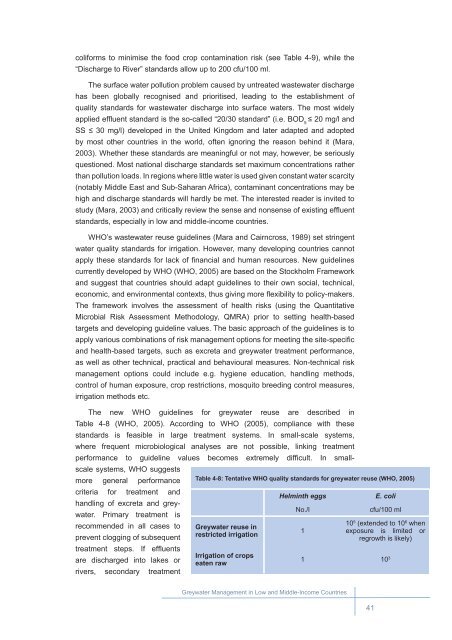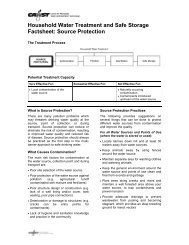Greywater Management in Low and Middle-Income Countries - SSWM
Greywater Management in Low and Middle-Income Countries - SSWM
Greywater Management in Low and Middle-Income Countries - SSWM
Create successful ePaper yourself
Turn your PDF publications into a flip-book with our unique Google optimized e-Paper software.
coliforms to m<strong>in</strong>imise the food crop contam<strong>in</strong>ation risk (see Table 4-9), while the<br />
<br />
The surface water pollution problem caused by untreated wastewater discharge<br />
has been globally recognised <strong>and</strong> prioritised, lead<strong>in</strong>g to the establishment of<br />
quality st<strong>and</strong>ards for wastewater discharge <strong>in</strong>to surface waters. The most widely<br />
5<br />
<br />
<br />
by most other countries <strong>in</strong> the world, often ignor<strong>in</strong>g the reason beh<strong>in</strong>d it (Mara,<br />
2003). Whether these st<strong>and</strong>ards are mean<strong>in</strong>gful or not may, however, be seriously<br />
questioned. Most national discharge st<strong>and</strong>ards set maximum concentrations rather<br />
than pollution loads. In regions where little water is used given constant water scarcity<br />
(notably <strong>Middle</strong> East <strong>and</strong> Sub-Saharan Africa), contam<strong>in</strong>ant concentrations may be<br />
high <strong>and</strong> discharge st<strong>and</strong>ards will hardly be met. The <strong>in</strong>terested reader is <strong>in</strong>vited to<br />
<br />
st<strong>and</strong>ards, especially <strong>in</strong> low <strong>and</strong> middle-<strong>in</strong>come countries.<br />
WHO’s wastewater reuse guidel<strong>in</strong>es (Mara <strong>and</strong> Cairncross, 1989) set str<strong>in</strong>gent<br />
water quality st<strong>and</strong>ards for irrigation. However, many develop<strong>in</strong>g countries cannot<br />
<br />
currently developed by WHO (WHO, 2005) are based on the Stockholm Framework<br />
<strong>and</strong> suggest that countries should adapt guidel<strong>in</strong>es to their own social, technical,<br />
<br />
The framework <strong>in</strong>volves the assessment of health risks (us<strong>in</strong>g the Quantitative<br />
Microbial Risk Assessment Methodology, QMRA) prior to sett<strong>in</strong>g health-based<br />
targets <strong>and</strong> develop<strong>in</strong>g guidel<strong>in</strong>e values. The basic approach of the guidel<strong>in</strong>es is to<br />
<br />
<strong>and</strong> health-based targets, such as excreta <strong>and</strong> greywater treatment performance,<br />
as well as other technical, practical <strong>and</strong> behavioural measures. Non-technical risk<br />
management options could <strong>in</strong>clude e.g. hygiene education, h<strong>and</strong>l<strong>in</strong>g methods,<br />
control of human exposure, crop restrictions, mosquito breed<strong>in</strong>g control measures,<br />
irrigation methods etc.<br />
The new WHO guidel<strong>in</strong>es for greywater reuse are described <strong>in</strong><br />
Table 4-8 (WHO, 2005). Accord<strong>in</strong>g to WHO (2005), compliance with these<br />
st<strong>and</strong>ards is feasible <strong>in</strong> large treatment systems. In small-scale systems,<br />
where frequent microbiological analyses are not possible, l<strong>in</strong>k<strong>in</strong>g treatment<br />
<br />
scale systems, WHO suggests<br />
more general performance <br />
criteria for treatment <strong>and</strong><br />
Helm<strong>in</strong>th eggs<br />
E. coli<br />
h<strong>and</strong>l<strong>in</strong>g of excreta <strong>and</strong> greywater.<br />
Primary treatment is<br />
No./l<br />
cfu/100 ml<br />
recommended <strong>in</strong> all cases to<br />
10<br />
<br />
(extended to 10 6 when<br />
1<br />
exposure is limited or<br />
prevent clogg<strong>in</strong>g of subsequent<br />
<br />
regrowth is likely)<br />
<br />
are discharged <strong>in</strong>to lakes or<br />
<br />
eaten raw<br />
1 10 3<br />
rivers, secondary treatment<br />
<strong>Greywater</strong> <strong>Management</strong> <strong>in</strong> <strong>Low</strong> <strong>and</strong> <strong>Middle</strong>-<strong>Income</strong> <strong>Countries</strong><br />
41
















